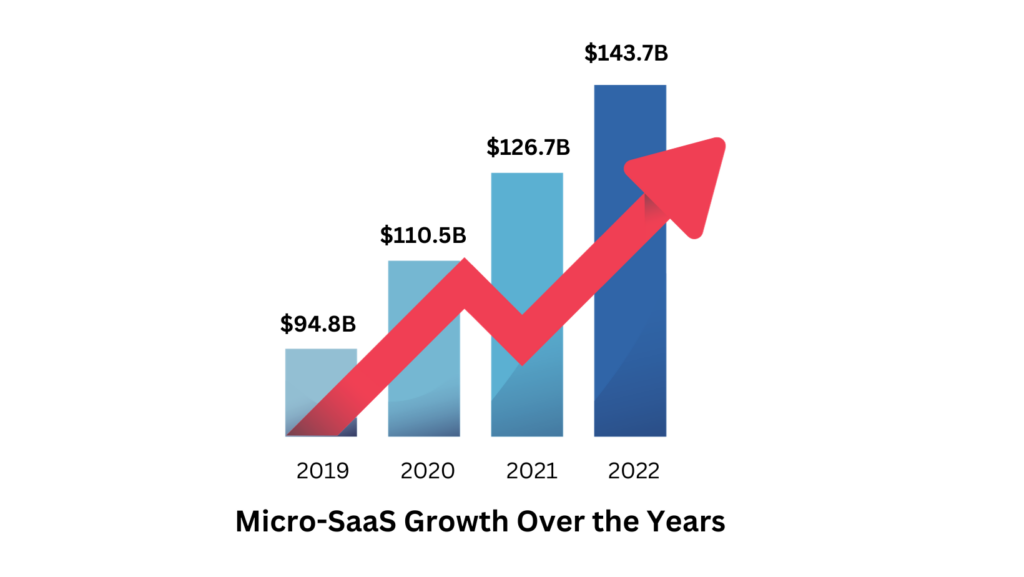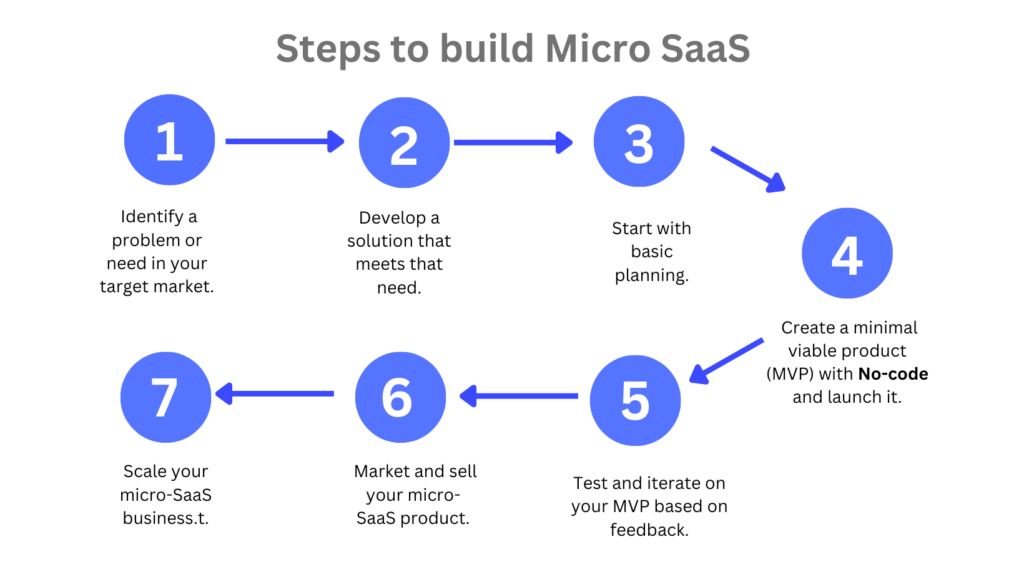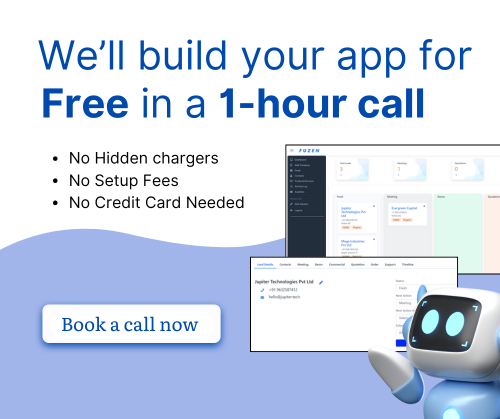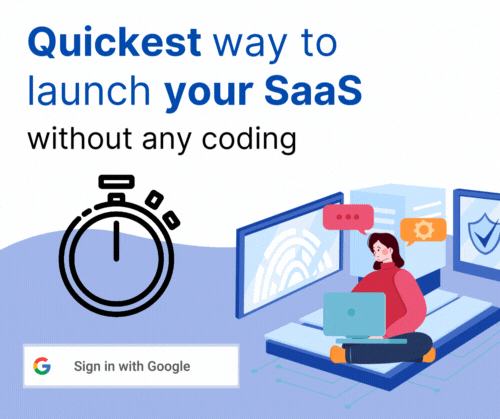Wondering how to build a micro SaaS? Then, you are at the right place. If you're a new entrepreneur looking for a way to start a business that's both profitable and not too big to handle, you're in for a great experience.
In this blog post, we'll guide you by providing insights and practical steps to help you understand how to build a micro SaaS business from the ground up.
What is micro SaaS And why should you care?
Before directly diving into steps on how to build a micro SaaS, let's first clear the basics - what is micro SaaS and why should you care?.
The idea of Micro-SaaS has given a new life to the startup world. It's all about creating small, specialized software-as-a-service (SaaS) businesses that tackle specific problems or meet certain needs for a particular audience.
The "micro" part of Micro-SaaS highlights its niche nature. These businesses are often run by just one person or a small team, making them incredibly manageable. Micro-SaaS is a great option for starting a small but strong business in the startup world.
Now, why should you care about Micro-SaaS? There are several compelling reasons:
- Profit Potential: Firstly, Micro-SaaS businesses can make good money and last a long time. By effectively addressing specific issues, they consistently provide value to customers and, in turn, generate reliable income.
- Niche Domination: Secondly, in a highly competitive landscape, Micro-SaaS offers the opportunity to specialize and excel. You can set yourself apart as the leading solution provider in your chosen niche by serving it with precision.
- Low Entry Barriers: What's even more appealing is that, with the right idea and execution, you can start a Micro-SaaS business with minimal investment. This makes it an accessible option for new entrepreneurs who may not have an abundance of resources to start with.
Have a look at the micro SaaS growth market over the years.
Finding Micro-SaaS Ideas
Now that we understand what Micro-SaaS is and why it's worth our attention, the next step is finding the right idea to kickstart your venture.
- Listen to Your Audience: Pay close attention to your potential customers. Firstly, engage with them through online forums, social media, or surveys. By actively listening, you can gain valuable insights into their pain points.
- Research the Market: Study your chosen market thoroughly. Investigate existing solutions and their limitations. See if there are gaps or areas where you can provide a better, more specialized answer.
- Consider Your Passion: Think about your interests and expertise. Sometimes, your own experiences can lead to unique insights into problems that need solving. Your passion can drive innovation.
- Collaborate and Brainstorm: Don't hesitate to collaborate with others. Brainstorming sessions with like-minded individuals can lead to fresh ideas. They might spot issues you haven't considered.
- Keep It Simple: Remember, Micro-SaaS is all about simplicity. Focus on addressing one specific problem exceptionally well rather than trying to do too much.
No code micro SaaS ideas for reference
Social Media Content Scheduler
A tool that allows users to plan, schedule, and post content across multiple social media platforms. Users can create content calendars, automate posting times, and analyze engagement metrics to optimize their social media strategy.
Automated Invoice Generator
A platform that enables freelancers and small businesses to create and send professional invoices automatically. Users can customize templates, set up recurring invoices, and track payment statuses, simplifying the billing process.
Event Registration and Management System
A solution for organizing and managing events, from workshops to large conferences. Users can create event pages, handle registrations, send reminders, and manage attendee lists without any coding knowledge.
Customer Feedback and Survey Tool
A no-code platform for creating and distributing surveys to gather customer feedback. Businesses can design custom surveys, analyze responses, and generate reports to understand customer satisfaction and improve their services.
Online Course Platform
A service that allows educators and trainers to create, manage, and sell online courses. Features include course building, student enrollment, progress tracking, and integration with payment gateways.
Appointment Booking System
A tool for businesses to manage appointments and bookings. Users can create booking pages, sync with calendars, send confirmation emails, and manage cancellations and rescheduling effortlessly.
Project Management Dashboard
A customizable project management tool that helps teams collaborate, track progress, and manage tasks. Users can create project timelines, assign tasks, set deadlines, and monitor project status in real-time.
Inventory Management System
A no-code solution for small retailers and e-commerce businesses to manage their inventory. Users can track stock levels, manage product listings, and generate reports to ensure efficient inventory control.
Validating Your Micro-SaaS Idea:
Once you've got a Micro-SaaS idea, the next step is to ensure it's worth your time and effort. Here's a quick guide to validate your idea:
- Talk to Your Audience: Engage with your target users. Further, conduct surveys, interviews, or online discussions to understand their needs and pain points.
- Check the Competition: Research existing solutions. Are there similar products? If yes, can you offer something better or different?
- Create a Prototype: Once you've checked out the competition, the next thing is to create a simple test version of your idea to see if it could work. It's important to note that this doesn't have to be a fully functional product; even a mock-up can work at this stage.
- Seek Feedback: Once you have your prototype or concept in hand, it's crucial to show it to potential users. Their feedback tells you if people like your idea and what changes you might need to make.
- Assess Market Demand: Lastly, take the time to assess the market. Look for real signs of demand for your solution, including current trends and customer needs. This information will help you make informed decisions about your Micro-SaaS venture.
How to build a micro SaaS?
1. Identify a problem or need in your target market.
- Listen to Your Audience: To begin, pay close attention to customer feedback from online forums, surveys, and social media. This will help you identify the issues or frustrations they express.
- Define the Pain Points: Once you've gathered this feedback, the next step is to define the specific problems your audience faces. Search for recurring themes or widespread issues.
- Prioritize the Problem: With the problems identified, it's crucial to assess their significance. Consider how many people are affected, how much it bothers them, and how much things can get better by fixing it.
- Ensure a Niche Focus: Keeping your focus narrow and well-defined is essential. Avoid the common pitfall of trying to address too many issues simultaneously. Simplicity and specificity are key to success.
- Research the Competition: Furthermore, study existing solutions in the market that address the same problem. This will help you understand what's already available and discover how you can stand out.
- Stay Open to Innovation: Last but not least, maintain an open mindset. Be willing to embrace creative thinking and unconventional approaches. Don't hesitate to explore unique ways to solve the problem, ensuring your Micro-SaaS sets itself apart.
2. Develop a solution that meets the need.
- Craft a user-centric solution: Firstly, ensure your solution is designed with your target audience's needs and preferences in mind.
- Keep it simple: Secondly, aim for user-friendliness and efficiency, avoiding unnecessary complexity.
- Address the problem directly: Your solution should directly tackle the pain points you've identified.
- Leverage your unique insights: Further, draw from your own experiences and industry knowledge to create an innovative solution.
- Maintain a clear focus: Lastly, focus on solving the exact problem without adding other stuff that doesn't matter.
3. Start with basic planning.
- Set Clear Objectives: To begin with, define your business goals and objectives. What do you want to achieve with your Micro-SaaS? Having a clear vision is crucial.
- Identify Your Target Audience: Once you've set your objectives, the next step is to understand your ideal customers. Who are they, and what are their needs? Tailor your plan to serve this specific audience.
- Business Model: Following audience identification, decide on the revenue model for your Micro-SaaS. Will you offer subscriptions, one-time payments, or a freemium model?
- Budget and Resources: With your business model in place, calculate the initial budget required for development, marketing, and operations. Ensure you have the necessary resources or access to them.
- Development Plan: Subsequently, plan the development process for your Minimal Viable Product (MVP). Outline the features and functionalities needed to address the identified problem.
- Timeline: Create a realistic timeline for your Micro-SaaS project, including milestones and deadlines for each phase.
- Legal and Compliance: As development progresses, make sure to address legal considerations, such as necessary licenses, data privacy regulations, and terms of service.
- Marketing Strategy: Once your legal aspects are covered, outline your initial marketing strategy. How will you reach your target audience and promote your Micro-SaaS?
- Team and Roles: If you have a team, define the roles within it. Clarify who is responsible for what aspects of the project to ensure a well-organized approach to your Micro-SaaS venture.
- Contingency Planning: Be prepared for unexpected challenges or setbacks. Consider alternative solutions in case things don't go as planned.
4. Create a minimal viable product (MVP) and launch it
- Use no-code platform: There are multiple no-code platforms and utilizing platforms like Fuzen enables you to create applications with ease. This approach streamlines your work, eliminating the requirement for coding and making tasks more straightforward.
- Develop Core Features: Focus on building the essential features that address the identified problem. Keep it simple and functional.
- Efficient Development: Prioritize speed over perfection. Your MVP doesn't need to be flawless, but it should work.
- User Testing: Test the MVP with a select group of users to gather feedback and identify any issues.
- Iterate and Improve: Use user feedback to refine and enhance the MVP. Make necessary changes based on real-world experiences.
- Early Launch: Don't wait for perfection. Launch your MVP as soon as it's functional. Start small and get it into the hands of your target audience.
- Monitor and Learn: Keep a close eye on user interactions and gather data. Learn from the MVP's performance and use it to shape your product's future development.
5. Test and iterate on your MVP based on feedback.
- Collect Feedback: To begin the process, actively seek feedback from users through surveys, reviews, and direct interactions. Pay close attention to their comments, suggestions, and pain points.
- Analyze Data: Next, examine user data and behavior to identify patterns and areas for improvement. Look for common issues and preferences among your users.
- Prioritize Changes: After gathering feedback and analyzing data, prioritize the most impactful changes. Focus on enhancements that align with your product's core purpose.
- Implement Iterations: Once you've identified the key improvements, make iterative changes to your MVP. This could involve adding features, enhancing the user experience, or fixing any identified problems.
- Communication: It's important to keep your users informed about updates and changes. Transparency builds trust and shows that you value their input.
- Repeat the Cycle: Continuous improvement is the goal. Regularly gather feedback, analyze it, prioritize changes, and make enhancements to keep your Micro-SaaS solution evolving and meeting user needs.
6. Market and sell your micro-SaaS product.
- Digital Marketing: Utilize digital channels like social media, content marketing, email marketing, and paid advertising to reach your target audience.
- Content Creation: Develop high-quality content such as blog posts, videos, and webinars to showcase your expertise and attract potential customers.
- Leverage SEO: Optimize your online presence for search engines to increase your product's discoverability.
- Social Proof: Showcase customer testimonials and reviews to build trust and credibility.
- Free Trials: Offer free trials or freemium versions to let users experience your product before committing.
- Pricing Strategy: Set competitive pricing that reflects the value your Micro-SaaS provides.
- Sales Funnel: Create a well-structured sales funnel to guide potential customers from awareness to conversion.
- Customer Support: Provide excellent customer support to address inquiries and assist users effectively.
7. Scale your micro-SaaS business.
- Expand Features: To take your Micro-SaaS to the next level, consider adding new features or functionalities to your product. This will not only improve user satisfaction but also attract a wider customer base and meet evolving needs.
- Diversify Customer Segments: In addition, explore different customer segments or industries that could benefit from your solution. This approach expands your market reach and opens up new growth opportunities.
- Build Partnerships: To maximize your reach, consider collaborating with complementary businesses or platforms. Partnering can help you leverage their customer base and increase your product's exposure.
- Invest in Marketing: Allocate resources to digital marketing, content creation, and social media strategies. These efforts will boost brand awareness and attract more customers, contributing to your business's growth.
- Optimize User Experience: Continuously improving the user experience based on feedback and data analysis is essential. This practice enhances customer satisfaction and ensures your product remains competitive.
- Hire and Expand Team: As your business grows, think about hiring additional team members to support development, customer support, and sales efforts. A strong team is key to managing growth effectively.
- Monitor Metrics: To make informed decisions, keep a close eye on key performance indicators. Regularly assess the effectiveness of your scaling strategies and use data-driven insights to guide your business forward.
Conclusion:
Micro-SaaS stands out because it can adjust, improve, and serve a specific audience. It lets you make a real difference while keeping your work manageable. So, now that you know how to build a micro SaaS and follow these steps given above and create your micro SaaS.
You can consider Fuzen to create your first Micro SaaS application with no code.





